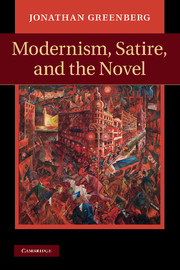Book contents
- Frontmatter
- Contents
- Illustration
- Preface
- Abbreviations
- Chapter 1 Satire and its discontents
- Chapter 2 Modernism's story of feeling
- Chapter 3 The rule of outrage: Evelyn Waugh's Vile Bodies
- Chapter 4 Laughter and fear in A Handful of Dust
- Chapter 5 Cold Comfort Farm and mental life
- Chapter 6 Nathanael West and the mystery of feeling
- Chapter 7 Nightwood and the ends of satire
- Chapter 8 Beckett's authoritarian personalities
- Notes
- Index
Chapter 8 - Beckett's authoritarian personalities
Published online by Cambridge University Press: 07 October 2011
- Frontmatter
- Contents
- Illustration
- Preface
- Abbreviations
- Chapter 1 Satire and its discontents
- Chapter 2 Modernism's story of feeling
- Chapter 3 The rule of outrage: Evelyn Waugh's Vile Bodies
- Chapter 4 Laughter and fear in A Handful of Dust
- Chapter 5 Cold Comfort Farm and mental life
- Chapter 6 Nathanael West and the mystery of feeling
- Chapter 7 Nightwood and the ends of satire
- Chapter 8 Beckett's authoritarian personalities
- Notes
- Index
Summary
Samuel Beckett, long discussed as a, if not the, final figure in the great procession of modernist writers, is a natural if not unavoidable figure in any investigation of late modernist satire. Yet while Murphy (1938) might seem the obvious choice for the completion of a study that has focused on the 1930s, I here choose to read a later novel, 1951's Molloy, sacrificing a bit of chronological unity in order to adumbrate how the idea of late modernist satire can be extended into the post-war years. In doing so, I aim to avoid a simplistic historicism by acknowledging the ways in which some of the post-war themes that emerge in this reading – Beckett's treatment of authority and compulsion – can, despite the undeniable impact of the war and the Holocaust, yet be seen as the fulfillment of emerging pre-war tendencies.
Chronologically, Molloy serves as an optimal text for reading Beckett as a late modernist. If any theorization of late modernism must rest in part upon discerning a skepticism toward or revision of earlier modernist practices, then the post-war moment would seem to solidify what was already emergent in the 1930s: the exhaustion of modernist romantic, revolutionary, or utopian energies. In describing late modernism, Fredric Jameson argues that “the Cold War spelled the end of a whole era of social transformations and indeed of Utopian desires and anticipations” – and in a different sense the Holocaust too put an end to such utopianism. At the same time, the major trends (and resurgent utopianisms) most frequently identified with postmodernism had yet to attain cultural centrality, so that the immediate post-war years present a lacuna in standard periodizations of the century.
- Type
- Chapter
- Information
- Modernism, Satire and the Novel , pp. 161 - 183Publisher: Cambridge University PressPrint publication year: 2011



